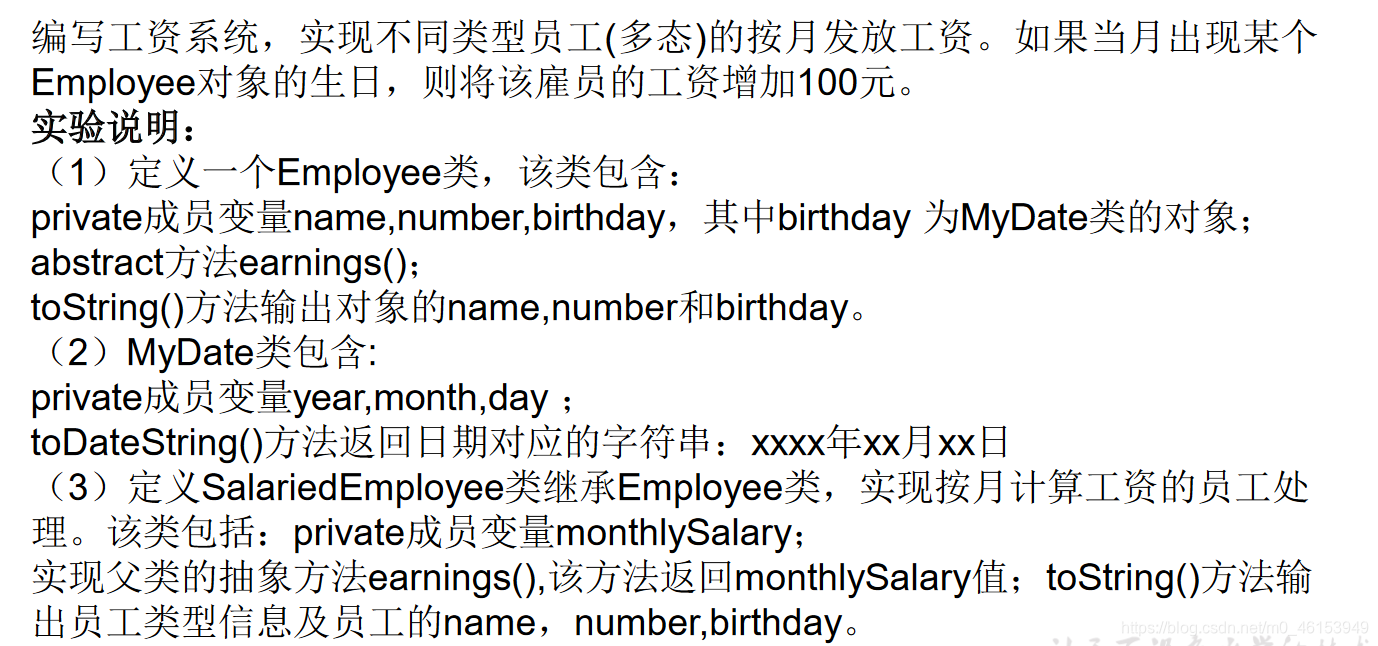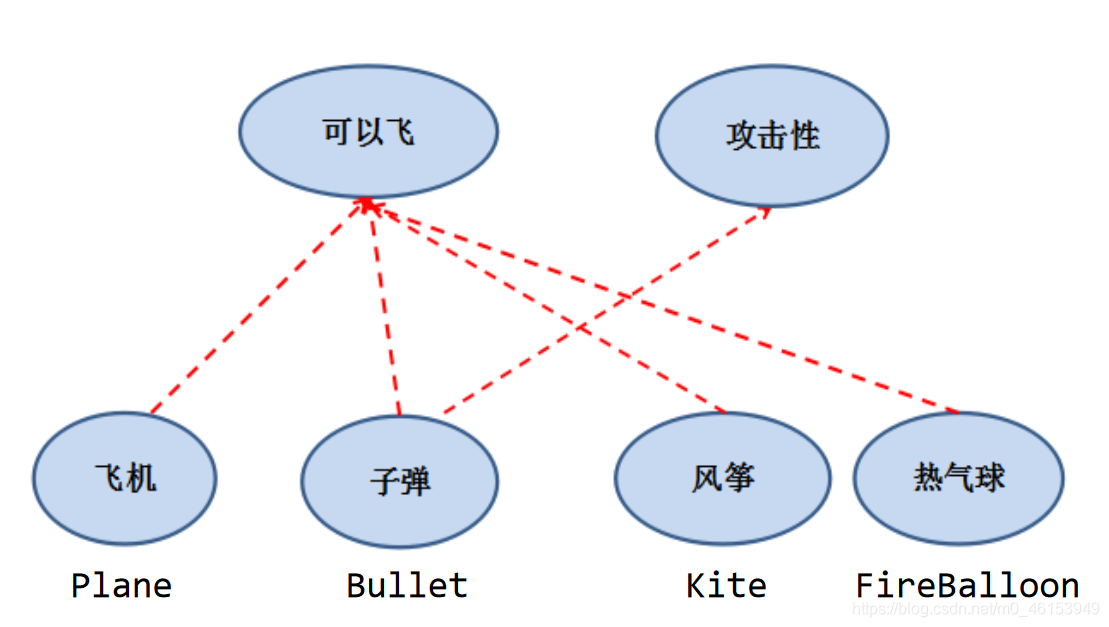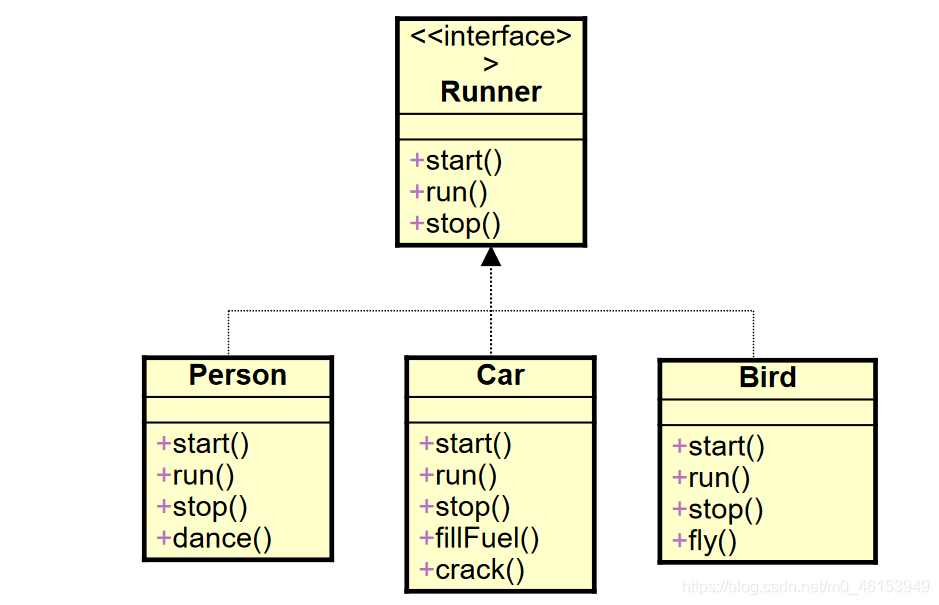原文:https://shimo.im/docs/JYXKDWDkYWQWGQPH/
《第四章 面向对象编程(下)》
第四章 面向对象(下)
抽象类与抽象方法
随着继承层次中一个个新子类的定义,类变得越来越具体,而父类则更一般,更通用。类的设计应该保证父类和子类能够共享特征。有时将一个父类设计得非常抽象,以至于它没有具体的实例,这样的类叫做
抽象类。

/** abstract 关键字的使用** 1.abstract:抽象的* 2.abstract 可以用来修饰的结构:类、方法* 3.abstract 修饰类:抽象类* 》 此类不能实例化* 》 抽象类中一定有构造器,便于子类实例化时调用(涉及:子类对象实例化全过程)* 》 开发中,都会提供抽象类的子类,让子类对象实例化,实现相关的操作** 4.abstract 修饰方法:抽象方法* > 抽象方法,只有方法的声明,没有方法体。* > 包含抽象方法的类,一定是一个抽象类。反之,抽象类中可以没有抽象方法* > 若子类重写了父类中所有的抽象方法,此子类,** abstract 使用上的注意点:* 1.abstract 不能用来修饰变量、代码块、构造器;** 2.abstract 不能用来修饰私有方法、静态方法、final 的方法、final 的类。**/public class AbstractTest {public static void main(String[] args) {//一旦 Person 类抽象了,就不可实例化// Person p1 = new Person();// p1.eat();}}abstract class Creature{public abstract void breath();}abstract class Person extends Creature{String name;int age;public Person(){}public Person(String name,int age){this.name = name;this.age = age;}//不是抽象方法// public void eat(){// System.out.println("人吃饭");// }//抽象方法public abstract void eat();public void walk(){System.out.println("人走路");}}class Student extends Person{public Student(String name,int age){super(name,age);}public void eat(){System.out.println("学生应该多吃有营养的。");}@Overridepublic void breath() {System.out.println("学生应该呼吸新鲜的无雾霾空气");}}
抽象类应用
抽象类是用来模型化那些父类无法确定全部实现,而是由其子类提供具体实现的对象的类。

问题:卡车(Truck)和驳船(RiverBarge)的燃料效率和行驶距离的计算方法完全不同。Vehicle 类不能提供计算方法,但子类可以。
/* Java 允许类设计者指定:超类声明一个方法但不提供实现,该方法的实现由子类提 供。这样的方法称为抽象方法。有一个或更多抽象方法的类称为抽象类。* Vehicle 是一个抽象类,有两个抽象方法。* 注意:抽象类不能实例化 new Vihicle()是非法的*/public abstract class Vehicle{public abstract double calcFuelEfficiency();//计算燃料效率的抽象方法public abstract double calcTripDistance();//计算行驶距离的抽象方法}public class Truck extends Vehicle{public double calcFuelEfficiency(){//写出计算卡车的燃料效率的具体方法}public double calcTripDistance(){//写出计算卡车行驶距离的具体方法}}public class RiverBarge extends Vehicle{public double calcFuelEfficiency() {//写出计算驳船的燃料效率的具体方法}public double calcTripDistance( ) {//写出计算驳船行驶距离的具体方法}}
练习
/** 编写一个 Employee 类,声明为抽象类,* 包含如下三个属性:name,id,salary。* 提供必要的构造器和抽象方法:work()。* 对于 Manager 类来说,他既是员工,还具有奖金(bonus)的属性。* 请使用继承的思想,设计 CommonEmployee 类和 Manager 类,* 要求类中提供必要的方法进行属性访问。**/public abstract class Employee {private String name;private int id;private double salary;public Employee(){super();}public Employee(String name, int id, double salary) {super();this.name = name;this.id = id;this.salary = salary;}public abstract void work();}
- Manager 类
/*
* 对于 Manager 类来说,他既是员工,还具有奖金(bonus)的属性。
*
*/
public class Manager extends Employee{
private double bonus; //奖金
public Manager(double bonus) {
super();
this.bonus = bonus;
}
public Manager(String name, int id, double salary, double bonus) {
super(name, id, salary);
this.bonus = bonus;
}
@Override
public void work() {
System.out.println("管理员工,提高公司运行效率。");
}
}
- CommonEmployee 类
public class CommonEmployee extends Employee {
@Override
public void work() {
System.out.println("员工在一线车间生产产品。");
}
}
- 测试类
/*
* 请使用继承的思想,设计 CommonEmployee 类和 Manager 类,
*/
public class EmployeeTest {
public static void main(String[] args) {
Employee manager = new Manager("库克",1001,5000,50000);
manager.work();
CommonEmployee commonEmployee = new CommonEmployee();
commonEmployee.work();
}
}
创建抽象类的匿名子类对象
public class Num {
}
abstract class Creature{
public abstract void breath();
}
abstract class Person extends Creature{
String name;
int age;
public Person(){
}
public Person(String name,int age){
this.name = name;
this.age = age;
}
//不是抽象方法
// public void eat(){
// System.out.println("人吃饭");
// }
//抽象方法
public abstract void eat();
public void walk(){
System.out.println("人走路");
}
}
class Student extends Person{
public Student(String name,int age){
super(name,age);
}
public Student(){
}
public void eat(){
System.out.println("学生应该多吃有营养的。");
}
@Override
public void breath() {
System.out.println("学生应该呼吸新鲜的无雾霾空气");
}
}
- PersonTest 类
/*
* 抽象类的匿名子类
*
*/
public class PersonTest {
public static void main(String[] args) {
method(new Student()); //匿名对象
Worker worker = new Worker();
method1(worker); //非匿名的类非匿名的对象
method1(new Worker()); //非匿名的类匿名的对象
System.out.println("*********************");
//创建了一个匿名子类的对象:p
Person p = new Person(){
@Override
public void eat() {
System.out.println("吃东西");
}
@Override
public void breath() {
System.out.println("呼吸空气");
}
};
method1(p);
System.out.println("**********************");
//创建匿名子类的匿名对象
method1(new Person(){
@Override
public void eat() {
System.out.println("吃零食");
}
@Override
public void breath() {
System.out.println("云南的空气");
}
});
}
public static void method1(Person p){
p.eat();
p.walk();
}
public static void method(Student s){
}
}
class Worker extends Person{
@Override
public void eat() {
}
@Override
public void breath() {
}
}
多态的应用:模板方法设计模式(TemplateMethod)
抽象类体现的就是一种模板模式的设计,抽象类作为多个子类的通用模板,子类在抽象类的基础上进行扩展、改造,但子类总体上会保留抽象类的行为方式。
解决的问题:
》当功能内部一部分实现是确定的,一部分实现是不确定的。这时可以把不确定的部分暴露出去,让子类去实现。
》换句话说,在软件开发中实现一个算法时,整体步骤很固定、通用,这些步骤已经在父类中写好了。但是某些部分易变,易变部分可以抽象出来,供不同子类实现。这就是一种模板模式。
- 例 1
/*
* 抽象类的应用:模板方法的设计模式
*/
public class TemplateTest {
public static void main(String[] args) {
SubTemlate t = new SubTemlate();
t.sendTime();
}
}
abstract class Template{
//计算某段代码执行所需花费的时间
public void sendTime(){
long start = System.currentTimeMillis();
code(); //不确定部分,易变的部分
long end = System.currentTimeMillis();
System.out.println("花费的时间为:" + (end - start));
}
public abstract void code();
}
class SubTemlate extends Template{
@Override
public void code() {
for(int i = 2;i <= 1000;i++){
boolean isFlag = true;
for(int j = 2;j <= Math.sqrt(i);j++){
if(i % j == 0){
isFlag = false;
break;
}
}
if(isFlag){
System.out.println(i);
}
}
}
}
- 例 2
//抽象类的应用:模板方法的设计模式
public class TemplateMethodTest {
public static void main(String[] args) {
BankTemplateMethod btm = new DrawMoney();
btm.process();
BankTemplateMethod btm2 = new ManageMoney();
btm2.process();
}
}
abstract class BankTemplateMethod {
// 具体方法
public void takeNumber() {
System.out.println("取号排队");
}
public abstract void transact(); // 办理具体的业务 //钩子方法
public void evaluate() {
System.out.println("反馈评分");
}
// 模板方法,把基本操作组合到一起,子类一般不能重写
public final void process() {
this.takeNumber();
this.transact();// 像个钩子,具体执行时,挂哪个子类,就执行哪个子类的实现代码
this.evaluate();
}
}
class DrawMoney extends BankTemplateMethod {
public void transact() {
System.out.println("我要取款!!!");
}
}
class ManageMoney extends BankTemplateMethod {
public void transact() {
System.out.println("我要理财!我这里有 2000 万美元!!");
}
}
模板方法设计模式是编程中经常用得到的模式。各个框架、类库中都有他的影子,比如常见的有:
- 数据库访问的封装
- Junit 单元测试
- JavaWeb 的 Servlet 中关于 doGet/doPost 方法调用
- Hibernate 中模板程序
- Spring 中 JDBCTemlate、HibernateTemplate 等
抽象类的练习


- Employee 类
/*
* 定义一个 Employee 类,
* 该类包含:private 成员变量 name,number,birthday,
* 其中 birthday 为 MyDate 类的对象;
* abstract 方法 earnings();
* toString()方法输出对象的 name,number 和 birthday。
*
*/
public abstract class Employee {
private String name;
private int number;
private MyDate birthday;
public Employee(String name, int number, MyDate birthday) {
super();
this.name = name;
this.number = number;
this.birthday = birthday;
}
public String getName() {
return name;
}
public void setName(String name) {
this.name = name;
}
public int getNumber() {
return number;
}
public void setNumber(int number) {
this.number = number;
}
public MyDate getBirthday() {
return birthday;
}
public void setBirthday(MyDate birthday) {
this.birthday = birthday;
}
public abstract double earnings();
@Override
public String toString() {
return "name=" + name + ", number=" + number + ", birthday=" + birthday.toDateString() + "]";
}
}
- MyDate 类
/*
* MyDate 类包含:private 成员变量 year,month,day;
* toDateString()方法返回日期对应的字符串:xxxx 年 xx 月 xx 日
*/
public class MyDate {
private int year;
private int month;
private int day;
public MyDate(int year, int month, int day) {
super();
this.year = year;
this.month = month;
this.day = day;
}
public int getYear() {
return year;
}
public void setYear(int year) {
this.year = year;
}
public int getMonth() {
return month;
}
public void setMonth(int month) {
this.month = month;
}
public int getDay() {
return day;
}
public void setDay(int day) {
this.day = day;
}
public String toDateString(){
return year + "年" + month + "月" + day + "日";
}
}
- SalariedEmployee 类
/*
* 定义 SalariedEmployee 类继承 Employee 类,实现按月计算工资的员工处理。
* 该类包括:private 成员变量 monthlySalary;实现父类的抽象方法 earnings(),
* 该方法返回 monthlySalary 值;
* toString()方法输出员工类型信息及员工的 name,number,birthday。
*
*/
public class SalariedEmployee extends Employee{
private double monthlySalary; //月工资
public SalariedEmployee(String name,int number,MyDate birthday) {
super(name,number,birthday);
}
public SalariedEmployee(String name, int number, MyDate birthday, double monthlySalary) {
super(name, number, birthday);
this.monthlySalary = monthlySalary;
}
@Override
public double earnings() {
return monthlySalary;
}
@Override
public String toString() {
return "SalariedEmployee [" + super.toString() + "]";
}
}
- HourlyEmployee 类
/*
* 参照 SalariedEmployee 类定义 HourlyEmployee 类,
* 实现按小时计算工资的员工处理。该类包括:private 成员变量 wage 和 hour;
* 实现父类的抽象方法 earnings(),该方法返回 wage*hour 值;
* toString()方法输出员工类型信息及员工的 name,number,birthday。
*
*/
public class HourlyEmployee extends Employee{
private int wage; //每小时的工资
private int hour; //月工作的小时数
public HourlyEmployee(String name, int number, MyDate birthday) {
super(name, number, birthday);
}
public HourlyEmployee(String name, int number, MyDate birthday, int wage, int hour) {
super(name, number, birthday);
this.wage = wage;
this.hour = hour;
}
@Override
public double earnings() {
return wage*hour;
}
public int getWage() {
return wage;
}
public void setWage(int wage) {
this.wage = wage;
}
public int getHour() {
return hour;
}
public void setHour(int hour) {
this.hour = hour;
}
public String toString(){
return "HourlyEmployee[" + super.toString() + "]";
}
}
- PayrollSystem 类
import java.util.Calendar;
import java.util.Scanner;
/*
* 定义 PayrollSystem 类,创建 Employee 变量数组并初始化,
* 该数组存放各类雇员对象的引用。利用循环结构遍历数组元素,
* 输出各个对象的类型,name,number,birthday,以及该对象生日。
* 当键盘输入本月月份值时,
* 如果本月是某个 Employee 对象的生日,还要输出增加工资信息。
*
*/
public class PayrollSystem {
public static void main(String[] args) {
//方式一:
// Scanner scanner = new Scanner(System.in);
// System.out.println("请输入当月的月份:");
// int month = scanner.nextInt();
//方式二:
Calendar calendar = Calendar.getInstance();
int month = calendar.get(Calendar.MONTH);//获取当前的月份
// System.out.println(month);//一月份:0
Employee[] emps = new Employee[2];
emps[0] = new SalariedEmployee("马良", 1002,new MyDate(1992, 2, 28),10000);
emps[1] = new HourlyEmployee("博西", 2001, new MyDate(1991, 1, 6),60,240);
for(int i = 0;i < emps.length;i++){
System.out.println(emps[i]);
double salary = emps[i].earnings();
System.out.println("月工资为:" + salary);
if((month+1) == emps[i].getBirthday().getMonth()){
System.out.println("生日快乐!奖励 100 元");
}
}
}
}
接口(interface)
概述
- 一方面,有时必须从几个类中派生出一个子类,继承它们所有的属性和方法。但是,Java 不支持多重继承。有了接口,就可以得到多重继承的效果。
- 另一方面,有时必须从几个类中抽取出一些共同的行为特征,而它们之间又没有 is-a 的关系,仅仅是具有相同的行为特征而已。例如:鼠标、键盘、打印机、扫描仪、摄像头、充电器、MP3 机、手机、数码相机、移动硬盘等都支持 USB 连接。
- 接口就是规范,定义的是一组规则,体现了现实世界中“如果你是/要…则必须能…”的思想。
继承是一个"是不是"的关系,而接口实现则是"能不能"的关系。 接口的本质是契约,标准,规范,就像我们的法律一样。制定好后大家都要遵守。

/* 接口(interface)是抽象方法和常量值定义的集合。
* 接口的特点:
* 用 interface 来定义。
* 接口中的所有成员变量都默认是由 publicstaticfinal 修饰的。
* 接口中的所有抽象方法都默认是由 publicabstract 修饰的。
* 接口中没有构造器。
* 接口采用多继承机制。
*/

/*
* 接口的使用
* 1.接口使用 interface 来定义。
* 2.在 Java 中:接口和类是并列的两个结构
* 3.如何去定义两个接口:定义接口中的成员
* 》3.1 JDK7 及以前:只能定义全局常量和抽象方法
* 》全局常量:public static final 的,但是书写中,可以省略不写。
* 》抽象方法:public abstract 的
*
* 》3.2 JDK8:除了全局常量和抽象方法之外,还可以定义静态方法、默认方法(略)。
*
* 4.接口中不能定义构造器!意味着接口不可以实例化。
*
* 5.Java 开发中,接口通过让类去实现(implements)的方式来使用。
* 如果实现类覆盖了接口中的所有方法,则此实现类就可以实例化
* 如果实现类没有覆盖接口中所有的抽象方法,则此实现类仍为一个抽象类
*
* 6.Java 类可以实现多个接口 ---》弥补了 Java 单继承性的局限性
* 格式:class AA extends BB implementd CC,DD,EE
*
* 7.接口与接口之间是继承,而且可以多继承
*
**********************************
* 8.接口的具体使用,体现多态性
* 接口的主要用途就是被实现类实现。(面向接口编程)
* 9.接口,实际可以看作是一种规范
*
* 面试题:抽象类与接口有哪些异同?
*
*/
public class InterfaceTest {
public static void main(String[] args) {
System.out.println(Flayable.MAX_SPEED);
System.out.println(Flayable.MIN_SPEED);
}
}
interface Flayable{
//全局变量
public static final int MAX_SPEED = 7900;
int MIN_SPEED = 1;//省略了 public static final
//抽象方法
public abstract void fly();
void stop();//省略了 public abstract
//Interfaces cannot have constructors
// public Flayable(){
//
// }
}
interface Attackable{
void attack();
}
class Plane implements Flayable{
@Override
public void fly() {
System.out.println("飞机通过引擎起飞");
}
@Override
public void stop() {
System.out.println("驾驶员减速停止");
}
}
abstract class Kite implements Flayable{
@Override
public void fly() {
}
}
class Bullet extends Object implements Flayable,Attackable,CC{
@Override
public void attack() {
// TODO Auto-generated method stub
}
@Override
public void fly() {
// TODO Auto-generated method stub
}
@Override
public void stop() {
// TODO Auto-generated method stub
}
@Override
public void method1() {
// TODO Auto-generated method stub
}
@Override
public void method2() {
// TODO Auto-generated method stub
}
}
//*********************************
interface AA{
void method1();
}
interface BB{
void method2();
}
interface CC extends AA,BB{
}


举例
/*
* 接口的使用
* 1.接口使用上也满足多态性
* 2.接口,实际上就是定义了一种规范
* 3.开发中,体会面向接口编程!
*
*/
public class USBTest {
public static void main(String[] args) {
Computer com = new Computer();
//1.创建了接口的非匿名实现类的非匿名对象
Flash flash = new Flash();
com.transferData(flash);
//2. 创建了接口的非匿名实现类的匿名对象
com.transferData(new Printer());
//3. 创建了接口的匿名实现类的非匿名对象
USB phone = new USB(){
@Override
public void start() {
System.out.println("手机开始工作");
}
@Override
public void stop() {
System.out.println("手机结束工作");
}
};
com.transferData(phone);
//4. 创建了接口的匿名实现类的匿名对象
com.transferData(new USB(){
@Override
public void start() {
System.out.println("mp3 开始工作");
}
@Override
public void stop() {
System.out.println("mp3 结束工作");
}
});
}
}
class Computer{
public void transferData(USB usb){//USB usb = new Flash();
usb.start();
System.out.println("具体传输数据的细节");
usb.stop();
}
}
interface USB{
//常量:定义了长、宽
void start();
void stop();
}
class Flash implements USB{
@Override
public void start() {
System.out.println("U 盘开始工作");
}
@Override
public void stop() {
System.out.println("U 盘结束工作");
}
}
class Printer implements USB{
@Override
public void start() {
System.out.println("打印机开启工作");
}
@Override
public void stop() {
System.out.println("打印机结束工作");
}
}
接口的应用:代理模式(Proxy)
概述:代理模式是 Java 开发中使用较多的一种设计模式。代理设计就是为其他对象提供一种代理以控制对这个对象的访问。

/*
* 接口的应用:代理模式
*
*
*/
public class NetWorkTest {
public static void main(String[] args) {
Server server = new Server();
// server.browse();
ProxyServer proxyServer = new ProxyServer(server);
proxyServer.browse();
}
}
interface NetWork{
public void browse();
}
//被代理类
class Server implements NetWork{
@Override
public void browse() {
System.out.println("真实的服务器来访问网络");
}
}
//代理类
class ProxyServer implements NetWork{
private NetWork work;
public ProxyServer(NetWork work){
this.work = work;
}
public void check(){
System.out.println("联网前的检查工作");
}
@Override
public void browse() {
check();
work.browse();
}
}
应用场景:
- 安全代理:屏蔽对真实角色的直接访问。
- 远程代理:通过代理类处理远程方法调用(RMI)
- 延迟加载:先加载轻量级的代理对象,真正需要再加载真实对象
比如你要开发一个大文档查看软件,大文档中有大的图片,有可能一个图片有 100MB,在打开文件时,不可能将所有的图片都显示出来,这样就可以使用代理模式,当需要查看图片时,用 proxy 来进行大图片的打开。
分类
- 静态代理(静态定义代理类)
动态代理(动态生成代理类)
- JDK 自带的动态代理,需要反射等知识
public class StaticProxyTest {
public static void main(String[] args) {
Proxy s = new Proxy(new RealStar());
s.confer();
s.signContract();
s.bookTicket();
s.sing();
s.collectMoney();
}
}
interface Star {
void confer();// 面谈
void signContract();// 签合同
void bookTicket();// 订票
void sing();// 唱歌
void collectMoney();// 收钱
}
//被代理类
class RealStar implements Star {
public void confer() {
}
public void signContract() {
}
public void bookTicket() {
}
public void sing() {
System.out.println("明星:歌唱~~~");
}
public void collectMoney() {
}
}
//代理类
class Proxy implements Star {
private Star real;
public Proxy(Star real) {
this.real = real;
}
public void confer() {
System.out.println("经纪人面谈");
}
public void signContract() {
System.out.println("经纪人签合同");
}
public void bookTicket() {
System.out.println("经纪人订票");
}
public void sing() {
real.sing();
}
public void collectMoney() {
System.out.println("经纪人收钱");
}
}
接口的应用:工厂模式
拓展:工厂设计模式.pdf
- 接口和抽象类之间的对比 | No. | 区别点 | 抽象类 | 接口 | | —- | —- | —- | —- | | 1 | 定义 | 包含抽象方法的类 | 主要是抽象方法和全局常量的集合 | | 2 | 组成 | 构造方法、抽象方法、普通方法、常量、变量 | 常量、抽象方法、(jdk8.0:默认方法、静态方法) | | 3 | 使用 | 子类继承抽象类(extends) | 子类实现接口(implements) | | 4 | 关系 | 抽象类可以实现多个接口 | 接口不能继承抽象类,但允许继承多个接口 | | 5 | 常见设计模式 | 模板方法 | 简单工厂、工厂方法、代理模式 | | 6 | 对象 | 都通过对象的多态性产生实例化对象 | | | 7 | 局限 | 抽象类有单继承的局限 | 接口没有此局限 | | 8 | 实际 | 作为一个模板 | 是作为一个标准或是表示一种能力 | | 9 | 选择 | 如果抽象类和接口都可以使用的话,优先使用接口,因为避免单继承的局限 | |
在开发中,常看到一个类不是去继承一个已经实现好的类,而是要么继承抽象类,要么实现接口。
-【面试题】排错:
interface A {
int x = 0;
}
class B {
int x = 1;
}
class C extends B implements A {
public void pX() {
// 编译不通过,x 不明确
System.out.println(x);
// System.out.println(super.x); //1
// System.out.println(A.x);//0
}
public static void main(String[] args) {
new C().pX();
}
}
- 排错 2:
interface Playable {
void play();
}
interface Bounceable {
void play();
}
interface Rollable extends Playable, Bounceable {
Ball ball= new Ball("PingPang"); //省略了 public static final
}
public class Ball implements Rollable {
private String name;
public String getName() {
return name;
}
public Ball(String name) {
this.name= name;
}
public void play() {
ball = new Ball("Football"); //The final field Rollable.ball cannot be assigned
System.out.println(ball.getName());
}
}
练习

CompareObject 类
/*
* 定义一个接口用来实现两个对象的比较。
*
*/
public interface CompareObject {
public int compareTo(Object o);
//若返回值是 0,代表相等;若为正数,代表当前对象大;负数代表当前对象小
}
- Circle 类
/*
* 定义一个 Circle 类,声明 redius 属性,提供 getter 和 setter 方法
*/
public class Circle {
private Double radius;
public Double getRadius() {
return radius;
}
public void setRadius(Double radius) {
this.radius = radius;
}
public Circle() {
super();
}
public Circle(Double radius) {
super();
this.radius = radius;
}
}
- ComparableCircle 类
/*
* 定义一个 ComparableCircle 类,继承 Circle 类并且实现 CompareObject 接口。在 ComparableCircle 类中给出接口中方法 compareTo 的实现体,
* 用来比较两个圆的半径大小。
*/
public class ComparableCircle extends Circle implements CompareObject{
public ComparableCircle(double radius) {
super(radius);
}
@Override
public int compareTo(Object o) {
if(this == o){
return 0;
}
if(o instanceof ComparableCircle){
ComparableCircle c = (ComparableCircle)o;
//错误的写法
// return (int)(this.getRedius() - c.getRedius());
//正确的方式一:
// if(this.getRadius() > c.getRadius()){
// return 1;
// }else if(this.getRadius() < c.getRadius()){
// return -1;
// }else{
// return 0;
// }
//当属性 radius 声明为 Double 类型时,可以调用包装类的方法
//正确的方式二:
return this.getRadius().compareTo(c.getRadius());
}else{
return 0;
// throw new RuntimeException("传入数据类型不匹配");
}
}
}
- InterfaceTest 类
/*
* 定义一个测试类 InterfaceTest,创建两个 ComparableCircle 对象,
* 调用 compareTo 方法比较两个类的半径大小。
*
*/
public class InterfaceTest {
public static void main(String[] args) {
ComparableCircle c1 = new ComparableCircle(3.4);
ComparableCircle c2 = new ComparableCircle(3.6);
int compareValue = c1.compareTo(c2);
if(compareValue > 0){
System.out.println("c1 对象大");
}else if(compareValue < 0){
System.out.println("c2 对象大");
}else{
System.out.println("两个一样的");
}
int compareValue1 = c1.compareTo(new String("AA"));
System.out.println(compareValue1);
}
}
Java 8 中关于接口的改进
Java 8 中,你可以为接口添加静态方法和默认方法。从技术角度来说,这是完全合法的,只是它看起来违反了接口作为一个抽象定义的理念。
静态方法:使用 static 关键字修饰。可以通过接口直接调用静态方法,并执行其方法体。我们经常在相互一起使用的类中使用静态方法。你可以在标准库中找到像 Collection/Collections 或者 Path/Paths 这样成对的接口和类。
默认方法:默认方法使用 default 关键字修饰。可以通过实现类对象来调用。我们在已有的接口中提供新方法的同时,还保持了与旧版本代码的兼容性。比如:java 8 API 中对 Collection、List、Comparator 等接口提供了丰富的默认方法。
- 例1
- interface 类
/*
* JDK8:除了全局常量和抽象方法之外,还可以定义静态方法、默认方法(略)。
*
*
*/
public interface CompareA {
//静态方法
public static void method1() {
System.out.println("CompareA:西安");
}
//默认方法
public default void method2(){
System.out.println("CompareA:深圳");
}
default void method3(){
System.out.println("CompareA:杭州");
}
}
- SubClassTest 类
public class SubClassTest {
public static void main(String[] args) {
SubClass s = new SubClass();
// s.method1();
// SubClass.method1();
// 知识点 1:接口中定义的静态方法,只能通过接口来调用。
CompareA.method1();
// 知识点 2:通过实现类的对象,可以调用接口中的默认方法。
// 如果实现类重写了接口中的默认方法,调用时,仍然调用的是重写以后的方法
s.method2();
// 知识点 3:如果子类(或实现类)继承的父类和实现的接口中声明了同名同参数的默认方法,
// 那么子类在没有重写此方法的情况下,默认调用的是父类中的同名同参数的方法。-->类优先原则
// 知识点 4:如果实现类实现了多个接口,而这多个接口中定义了同名同参数的默认方法,
// 那么在实现类没有重写此方法的情况下,报错。-->接口冲突。
// 这就需要我们必须在实现类中重写此方法
s.method3();
}
}
class SubClass extends SuperClass implements CompareA,CompareB{
public void method2(){
System.out.println("SubClass:上海");
}
public void method3(){
System.out.println("SubClass:深圳");
}
// 知识点 5:如何在子类(或实现类)的方法中调用父类、接口中被重写的方法
public void myMethod(){
method3(); //调用自己定义的重写的方法
super.method3(); //调用的是父类中声明的
// 调用接口中的默认方法
CompareA.super.method3();
CompareB.super.method3();
}
}
- SuperClass 类
public class SuperClass {
public void method3(){
System.out.println("SuperClass:北京");
}
}
- CompareB 类
public interface CompareB {
default void method3(){
System.out.println("CompareB:上海");
}
}
- 例2
/*
* 练习:接口冲突的解决方式
*/
interface Filial {// 孝顺的
default void help() {
System.out.println("老妈,我来救你了");
}
}
interface Spoony {// 痴情的
default void help() {
System.out.println("媳妇,别怕,我来了");
}
}
class Father{
public void help(){
System.out.println("儿子,救我媳妇!");
}
}
class Man extends Father implements Filial, Spoony {
@Override
public void help() {
System.out.println("我该就谁呢?");
Filial.super.help();
Spoony.super.help();
}
}
类的内部成员之五:内部类
当一个事物的内部,还有一个部分需要一个完整的结构进行描述,而这个内部的完整的结构又只为外部事物提供服务,那么整个内部的完整结构最好使用内部类。
/*
* 类的内部成员之五:内部类
*
* 1.Java中允许将一个类A声明在另一个类B中,则类A就是内部类,类B就是外部类.
*
* 2.内部类的分类:成员内部类 VS 局部内部类(方法内、代码块内、构造器内)
*
* 3.成员内部类
* 》作为外部类的成员,
* - 调用外部类的结构
* - 可以被static修饰
* - 可以被4种不同的权限修饰
*
* 》作为一个类,
* - 类内可以定义属性、方法、构造器等
* - 可以被final修饰,表示此类不能被继承。言外之意,不使用final,就可以被继承
* - 可以abstract修饰
*
* 4.关注如下的3个问题
* 》 如何实例化成员内部类的对象
* 》 如何在成员内部类中区分调用外部类的结构
* 》 开发中局部内部类的使用 见《InnerClassTest1.java》
*/
public class InnerClassTest {
public static void main(String[] args) {
//创建Dog实例(静态的成员内部类)
Person.Dog dog = new Person.Dog();
dog.show();
//创建Bird实例(非静态的成员内部类)
// Person.Bird bird = new Person.Bird();
Person p = new Person();
Person.Bird bird = p.new Bird();
bird.sing();
System.out.println();
bird.display("喜鹊");
}
}
class Person{
String name = "李雷";
int age;
public void eat(){
System.out.println("人,吃饭");
}
//静态成员内部类
static class Dog{
String name;
int age;
public void show(){
System.out.println("卡拉是条狗");
// eat();
}
}
//非静态成员内部类
class Bird{
String name = "杜鹃";
public Bird(){
}
public void sing(){
System.out.println("我是一只猫头鹰");
Person.this.eat();//调用外部类的非静态属性
eat();
System.out.println(age);
}
public void display(String name){
System.out.println(name); //方法的形参
System.out.println(this.name); //内部类的属性
System.out.println(Person.this.name); //外部类的属性
}
}
public void method(){
//局部内部类
class AA{
}
}
{
//局部内部类
class BB{
}
}
public Person(){
//局部内部类
class CC{
}
}
}
- InnerClassTest1类
public class InnerClassTest1 {
// 开发中很少见
public void method(){
// 局部内部类
class AA{
}
}
// 返回一个实现了Comparable接口的类的对象
public Comparable getComparable(){
// 创建一个实现了Comparable接口的类:局部内部类
//方式一:
// class MyComparable implements Comparable{
//
// @Override
// public int compareTo(Object o) {
// return 0;
// }
//
// }
//
// return new MyComparable();
//方式二:
return new Comparable(){
@Override
public int compareTo(Object o) {
return 0;
}
};
}
}
匿名内部类
/*
* 1.匿名内部类不能定义任何静态成员、方法和类,只能创建匿名内部类的一个实例。
* 一个匿名内部类一定是在new的后面,用其隐含实现一个接口或实现一个类。
*
* 2.格式:
* new 父类构造器(实参列表)|实现接口(){
* //匿名内部类的类体部分
* }
*
* 3.匿名内部类的特点
* > 匿名内部类必须继承父类或实现接口
* > 匿名内部类只能有一个对象
* > 匿名内部类对象只能使用多态形式引用
*/
interface Product{
public double getPrice();
public String getName();
}
public class AnonymousTest{
public void test(Product p){
System.out.println("购买了一个" + p.getName() + ",花掉了" + p.getPrice());
}
public static void main(String[] args) {
AnonymousTest ta = new AnonymousTest();
//调用test方法时,需要传入一个Product参数,
//此处传入其匿名实现类的实例
ta.test(new Product(){
public double getPrice(){
return 567.8;
}
public String getName(){
return "AGP显卡";
}
});
}
}
局部内部类的使用注意
public class InnerClassTest {
// public void onCreate(){
//
// int number = 10;
//
// View.OnClickListern listener = new View.OnClickListener(){
//
// public void onClick(){
// System.out.println("hello!");
// System.out.println(number);
// }
//
// }
//
// button.setOnClickListener(listener);
//
//}
/*
* 在局部内部类的方法中(比如:show)如果调用局部内部类所声明的方法(比如:method)中的局部变量(比如:num)的话,
* 要求此局部变量声明为final的。
*
* jdk 7及之前版本:要求此局部变量显式的声明为final的
* jdk 8及之后的版本:可以省略final的声明
*
*/
public void method(){
//局部变量
int num = 10;
class AA{
public void show(){
// num = 20; //Local variable num defined in an enclosing scope must be final or effectively final
System.out.println(num);
}
}
}
}
面向对象思维导图总结
导图1

导图2

整个Java全栈系列都是笔者自己敲的笔记。写作不易,如果可以,点个赞呗!✌

